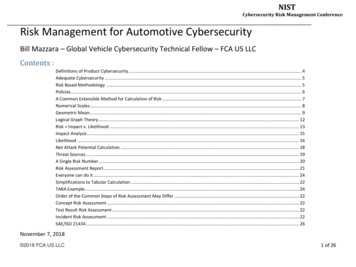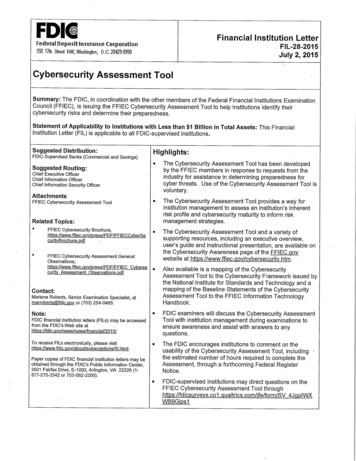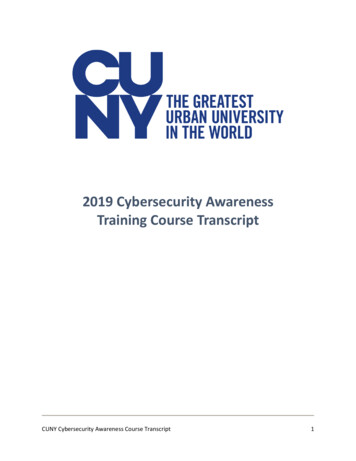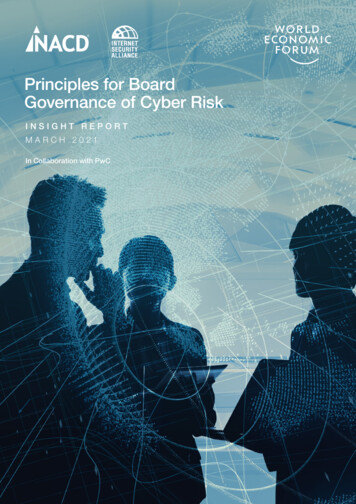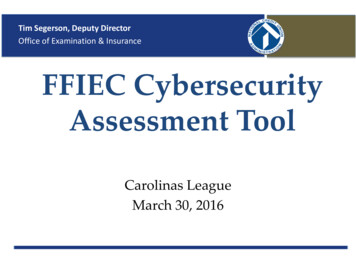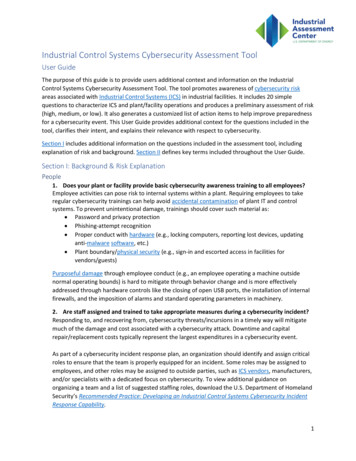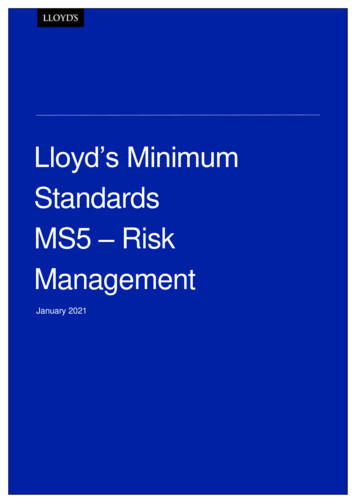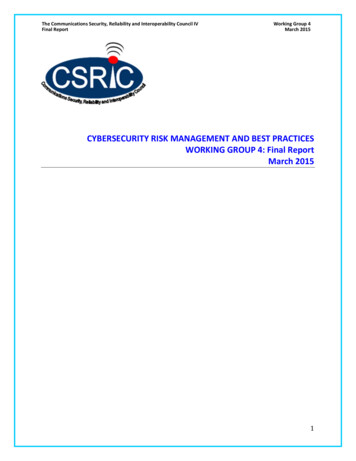
Transcription
The Communications Security, Reliability and Interoperability Council IVFinal ReportWorking Group 4March 2015CYBERSECURITY RISK MANAGEMENT AND BEST PRACTICESWORKING GROUP 4: Final ReportMarch 20151
The Communications Security, Reliability and Interoperability Council IVFinal ReportWorking Group 4March 2015TABLE of CONTENTSI. EXECUTIVE SUMMARY . 4A. Voluntary Mechanisms. 6B. Guidance to Individual Companies on the Use of the NIST Framework. 8C. Communication Sector Commitment to Advancing Cybersecurity RiskManagement . 10II. INTRODUCTION . 11III. BACKGROUND . 13A. CSRIC Structure . 15B. Leadership Team . 16C. Working Group 4 Team Members . 16IV. OBJECTIVE, SCOPE, AND METHODOLOGY . 19A. Objective . 19B. Scope . 20C. Methodology . 21V. FINDINGS . 24A. Macro‐Level Assurance Findings . 24B. Voluntary Mechanisms Findings . 25C. Use of the NIST Cybersecurity Framework or an Equivalent ConstructFindings . 25D. Meaningful Indicators Findings . 25E. Communications Sector Implementation Guidance Findings . 26VI. CONCLUSIONS . 27A. Macro‐Level Assurance Conclusions . 27B. Voluntary Mechanisms Conclusions. 27C. Use of NIST Cybersecurity Framework or Equivalent Construct Conclusions. 28D. Meaningful Indicators Conclusions . 28E. Communications Sector Implementation Guidance Conclusions . 28VII. RECOMMENDATIONS . 30A. Macro‐Level Assurance Recommendations . 30B. Voluntary Mechanisms Recommendations. 30C. Use of NIST Cybersecurity Framework or Equivalent ConstructRecommendation . 31D. Meaningful Indicators Recommendations . 31E. Communications Sector Implementation Guidance Recommendations . 312
The Communications Security, Reliability and Interoperability Council IVFinal ReportWorking Group 4March 2015VIII. ACKNOWLEDGEMENTS . 33IX. REPORTS & SEGMENTS. 349.1 BROADCAST SEGMENT . 359.2 CABLE SEGMENT . 629.3 SATELLITE SEGMENT . 919.4 WIRELESS SEGMENT . 1189.5 WIRELINE SEGMENT . 1679.6 REQUIREMENTS AND BARRIERS TO IMPLEMENTATION . 2029.7 CYBER ECOSYSTEM AND DEPENDENCIES . 3219.8 MEASUREMENT . 3559.9 SMALL AND MEDIUM BUSINESS . 3709.10 TOP CYBER THREATS AND VECTORS . 3983
The Communications Security, Reliability and Interoperability Council IVFinal ReportWorking Group 4March 2015I. EXECUTIVE SUMMARYCSRIC IV Working Group 4 (WG4) was given the task of developing voluntary mechanisms thatgive the Federal Communications Commission (FCC) and the public assurance thatcommunication providers are taking the necessary measures to manage cybersecurity risksacross the enterprise.1 WG4 also was charged with providing implementation guidance to helpcommunication providers use and adapt the voluntary NIST Cybersecurity Framework2(hereinafter “NIST CSF”).Working Group 4 began its work shortly after the Communications Sector3 completed a highlycollaborative, multi‐stakeholder process that resulted in the NIST CSF Version 1.04 that wascalled for in the President’s Executive Order 13636 – Improving Critical InfrastructureCybersecurity.5 The sector’s participation in CSRIC WG4 was seen as an opportunity to assumethe leadership urged by FCC Chairman Tom Wheeler in a speech delivered to the AmericanEnterprise Institute in June 2014.6 By building on the cross‐sector NIST CSF and by framing itsapplicability to five major communications industry segments, the Working Group was able toformulate and commit to several voluntary mechanisms that provide the macro‐levelassurances sought by the FCC. Moreover, these mechanisms, combined with the insights, tools,guidance, and fact‐based analyses developed by over 100 cybersecurity professionals whoparticipated in a year‐long effort to produce this report, validate the advantages of a non‐regulatory approach over a prescriptive and static compliance regime.7WG4 organized itself into five segment subgroups representing the five key parts of thecommunication industry. Their representatives were encouraged to pursue independentevaluations of the CSRIC WG4 charge based on their own operating environments. The fivesegments included:1See Federal Communications Commission, CSRIC IV Working Group Descriptions and Leadership (2013), availableat http://transition.fcc.gov/pshs/advisory/csric4/wg descriptions.pdf.2See National Institute for Standards and Technology, Framework for Improving Cybersecurity, 79 FR 9167 (Feb.18, 2014) [hereinafter NIST CSF], available at urity‐framework‐021214.pdf.3For purposes of this report, the “Communications Sector” is comprised of five industry segments includingbroadcast, cable, satellite, wireless, and wireline network service providers.4See NIST CSF.5See Exec. Order No. 13,691, Promoting Private Sector Cybersecurity Information Sharing, 80 FR 9347 (Feb. 13,2015) [hereinafter EO 13691].6See Remarks of FCC Chairman Tom Wheeler, American Enterprise Institute, June 12, 2014, available dc [hereinafterChairman Wheeler’s Remarks] (“[T]he network ecosystem must step up to assume new responsibility and marketaccountability for managing cyber risks.”).7Id. (statement of Chairman Tom Wheeler) (“[W]e cannot hope to keep up if we adopt a prescriptive regulatoryapproach. We must harness the dynamism and innovation of competitive markets to fulfill our policy and developsolutions. We are therefore challenging private sector stakeholders to create a “new regulatory paradigm” ofbusiness‐driven cybersecurity risk management.”).4
The Communications Security, Reliability and Interoperability Council IVFinal ReportWorking Group 4March 2015 Broadcast: There are more than 15,000 radios and 1,700 televisions broadcastingfacilities in the United States, providing news, emergency information and otherprogramming services over the air to consumers.8 Cable: The cable industry is composed of approximately 7,791 cable systems9 that offeranalog and digital video programming services, digital telephone service, and high‐speed Internet access service. Satellite: Satellite communications systems use a combination of space‐basedinfrastructure and ground equipment capable of delivering data, voice, video, andbroadcast communications to any person in the U.S., its territories, and anywhere onthe globe. Wireless: The Wireless industry delivers advanced wireless broadband services thatinclude data, voice and video to more than 335 million active wireless‐devicesnationwide, including more than 175 million smartphones, 25 million tablets, and 51million data‐only devices.10 There are approximately 160 facilities‐based wirelesscarriers11 in United States that operate and maintain more than 304,360 cell sites12 thatcollectively provide the most advanced 4G technology deployment in the world. Wireline: Over 1,000 companies offer wireline, facilities‐based communications servicesin the United States.13 Wireline companies serve as the backbone of the Internet.WG4 also established five “feeder” subgroups to engage in a deeper, more focused analysis ofsubject matter areas that would help the communications sector segments evaluate theircybersecurity risk environment, posture, and tolerance. To ensure that the voluntarymechanisms and sector guidance were grounded in facts, thoughtful judgments, and practicalin their design, the following “feeder” topics were examined: Cyber Ecosystem and DependenciesTop Threats and VectorsFramework Requirements and Barriers8National Association of Broadcasters, Legislative Priorities 111th Congress, 4, available athttp://nab.org/documents/advocacy/NAB 111th Legislative Priorities.pdf.9See U.S. Communications Sector Coordinating Council, The Communications Sector, http://www.commscc.org/(last visited March 13, 2015).10Cellular Telephone Industries Association (CTIA), Wireless Industry Indices Report ‐ Year‐End 2013 133 (June2014).11Federal Communications Commission, Local Telephone Competition: Status as of December 31, 2013, 29 (Oct.2014), available at http://transition.fcc.gov/Daily Releases/Daily Business/2015/db0219/DOC‐329975A1.pdf.12Cellular Telephone Industries Association (‘CTIA’), Wireless Annual Wireless Industry y‐survey (last visited Mar. 132015).13See id.5
The Communications Security, Reliability and Interoperability Council IVFinal Report Working Group 4March 2015Small and Medium BusinessesMeasurementsEach of the segment subgroups, informed by the findings of the topical feeder subgroups,evaluated the applicability of the NIST Cybersecurity Framework’s 98 subcategories to theirsegment, prioritized the applicable subcategories on an illustrative basis, and assessed thechallenges of implementation and effectiveness for each applicable subcategory. The segmentand feeder subgroup findings and resulting NIST Cybersecurity Framework implementationguidance are contained in the appendices to this report.The key macro‐level assurances developed by WG4 were designed to demonstrate howcommunications providers are appropriately managing cybersecurity risks through theapplication of the NIST Cybersecurity Framework, or an equivalent construct. The FCCdescribed the desired characteristics of the assurances as:14 Tailored by individual companies to suit their unique needs, characteristics, and risks;Based on meaningful indicators of successful cyber risk management; andAllowing for meaningful assessments both internally and externally.A. Voluntary MechanismsAs evidence of the Communications Sector’s commitment to enhance cybersecurity riskmanagement capabilities across the sector and the broader ecosystem, and to promote useof the NIST CSF, CSRIC recommends three new voluntary mechanisms to provide theappropriate macro‐level assurances: FCC initiated confidential company‐specific meetings, or similar communicationformats to convey their risk management practices. The meetings would be coveredby protections afforded under the Protected Critical Infrastructure Information(PCII)15 administered by the Department of Homeland Security (DHS);A new component of the Communications Sector Annual Report that focuses onsegment‐specific cybersecurity risk management, highlighting efforts to managecybersecurity risks to the core critical infrastructure; andActive and dedicated participation in DHS’ Critical Infrastructure Cyber CommunityC3 Voluntary Program,16 to help industry increase cybersecurity risk managementawareness and use of the Framework.14See supra note 1, at 4.See Department of Homeland Security, Protected Critical Information Program, ucture‐information‐pcii‐program (last visited Mar. 13, 2015) [hereinafter PCII Program].16See Department of Homeland Security, About the Critical Infrastructure Cyber Community C³ Voluntary ry‐program (last visited Mar.13, 2015) [hereinafter DHS C3 Voluntary Program].156
The Communications Security, Reliability and Interoperability Council IVFinal ReportWorking Group 4March 20151) Confidential Company‐Specific Meetings: The sector supports the development ofa voluntary program for periodic meetings, or an alternative means ofcommunications among the FCC, DHS, and individual companies that agree toparticipate. The purpose of these meetings would be to discuss efforts by theorganizations to develop risk management practices consistent with the NISTCybersecurity Framework or equivalent constructs. During the meetings, theparticipating companies would share information regarding cyber threats or attackson their critical infrastructure, and the organizations’ effort to respond or recoverfrom such threats or attacks. Companies that choose to participate in this programwould be afforded the protections that are given by the federal government tocritical infrastructure owners and operators under the PCII program or a legallysustainable equivalent. This voluntary mechanism represents a new level of industrycommitment intended to promote additional transparency, visibility, and dialoguewith appropriate government partners and our regulator in the area of cybersecurityrisk management.2) Sector Annual Report: The Sector recognizes that the increasing frequency,sophistication, and destructive nature of cyber‐attacks spurs concerns about whatcompanies are doing to manage their cybersecurity risks. WG4 initiated the“Measurement” subgroup to analyze how to best demonstrate the overall state ofcybersecurity within the communications sector. The Measurement subgrouprecommends that the Communications Sector Coordinating Council (CSCC), as theofficial interface for the sector can include information on the cybersecurity ofcritical communications network infrastructure in future drafts of the Sector AnnualReport (SAR) starting in 2015. The SAR would then be provided to DHS, which is thecommunications sector’s SSA, and the Government Coordinating Council (GCC),which includes the FCC. This new voluntary mechanism reflects a materialenhancement to the existing SAR because it would provide greater insight into thethreats posed to the sector, and the actions taken to ensure continued availability ofthe core network infrastructure and the critical services that depend on itsavailability and integrity.3) Active Participation in DHS C3Outreach and Education: The Department ofHomeland Security oversees a program that it created in response to a directivecontained in Executive Order 13636. DHS created the Critical Infrastructure CyberCommunity C³ Voluntary Program as part of what it describes as an “innovativepublic‐private partnership designed to help align critical infrastructure owners andoperators with existing resources that will assist their efforts to adopt theCybersecurity Framework and manage their cyber risks.”17 The Program emphasizesthree C’s:17See DHS C3 Voluntary Program.7
The Communications Security, Reliability and Interoperability Council IVFinal Report Working Group 4March 2015Converging critical infrastructure community resources to supportcybersecurity risk management and resilience through use of the Framework;Connecting critical infrastructure stakeholders to the national resilience effortthrough cybersecurity resilience advocacy, engagement, and awareness; andCoordinating critical infrastructure cross sector efforts to maximize nationalcybersecurity resilience.The Communications Sector has already participated in development activities and was recentlyfeatured in the first of a series of C³ webinars where CSRIC Working Group 4 activities weredescribed.18 To advance the use of the Framework through the implementation guidancecontained in this report and from other sources, the communications sector will develop aseries of webinars and other reference materials. The goal is to increase awareness by sectorenterprises, guide their use of the NIST CSF and explain the innovative processes, solutions, andlessons learned from the communication sector’s leaders in using the Framework.B. Guidance to Individual Companies on the Use of the NIST FrameworkCharged with providing implementation guidance to facilitate the use and adaptation of thevoluntary NIST Cybersecurity Framework by communications providers, the WG4 membersdeveloped and applied a variety of analytical tools and methods that could serve as aprimer for companies when reviewing their own risk management processes. The NIST CSFVersion 1.0 offers organizations direction when they are implementing or enhancing theircybersecurity risk management program. In addition, the report provides informativereferences that include leading cybersecurity protocols, resources, and tools. NISTemphasized the “voluntary” nature of the Framework, noting that it is designed to use“business drivers to guide cybersecurity activities” and to “manage cybersecurity risk in acost‐effective way based on business needs without placing additional regulatoryrequirements on businesses.”19While this report incorporates findings, conclusions, and recommendations related toguiding individual companies on the use of the Framework, many communicationscompanies have long‐standing and mature cybersecurity risk management capabilities andothers within the communications sector did not wait for this report to be finalized beforebeginning their evaluation of the applicability of the Framework components to theirenterprise. Reducing cybersecurity risk by implementing widely recognized standards andguidelines20 has been a hallmark of communications industry practice, and is supported by18See Department of Homeland Security, C Cubed Voluntary Program, https://share.dhs.gov/p1qqp8dvu34/ (lastvisited Mar. 13, 2015).19See NIST CSF.20See Government Accountability Office, Critical Infrastructure Protection – Cybersecurity Guidance is Available,but More Can Be Done to Promote Its Use (Dec. 2011), available at http://www.gao.gov/assets/590/587529.pdf.8
The Communications Security, Reliability and Interoperability Council IVFinal ReportWorking Group 4March 2015exceptionally high levels of service availability.21 Notwithstanding this fact, the NISTFramework is a seminal document in organizing risk management activities across a broadglobal landscape. Over 100 professionals from across the communications sector and thebroader stakeholder community have worked tirelessly over the past 12 months to producea report with recommendations on Framework use which should have immediate andpractical value for individual sector companies and other key stakeholders.1) Governance: The NIST Framework emphasizes the importance of taking a holisticapproach to cybersecurity, viewing it as an enterprise‐wide, strategic riskmanagement matter, rather than as a narrow information technology (IT) ornetwork management domain.When managing cybersecurity risks, it is essential to incorporate a risk governanceprocess into the program. The key objective is to ensure that an inclusive,independent, and holistic assessment of the current and future enterprise riskposture is routinely undertaken, and to align the enterprise’s business mission withsound and effective cybersecurity practices, protocols, and tools. For manycompanies, establishment of a dedicated cross‐enterprise cybersecurity riskgovernance function can facilitate this key objective. Such a governance authorityshould be sufficiently representative of the organization to achieve the following: Identify potential risks and a variety of risk tolerance perspectives;Apply independence and authority to risk management activities;Ensure transparency through the risk decision making and implementationprocess;Define and communicate the enterprise’s risk tolerance; andContinually adapt and assess cybersecurity risk management goals andobjectives.While the specific structure and operational practices of these governing bodies canand will vary among individual companies, the foundational principle is that everycompany should treat cybersecurity as a key component of overall enterprise riskmanagement.2) NIST CSF Implementation Recommendations: The WG4 industry segment subgroupreports in the appendices to this report provide concrete guidance on how to usethe Framework can bolster cyber readiness. Each WG4 segment subgroup reportsurveys infrastructure core assets and critical services, and also employs use cases,all with the aim of offering guidance in how to incorporate the risk management21See Federal Communications Commission, Network Outage Reporting System /nors/nors.html (last visited Mar. 13, 2015) (a web‐based filing systemthrough which communications providers covered by C.F.R. Part 4 reporting rules submit outage reports to theFCC, and allows the FCC to perform analyses and studies of the communications disruptions reported).9
The Communications Security, Reliability and Interoperability Council IVFinal ReportWorking Group 4March 2015protocols and practices referenced in the Framework with the operatingenvironment of the respective industry segment.In addition to the segment‐specific guidance provided to broadcast, cable, satellite,wireless and wireline companies through the industry segment subgroup reports,WG4 also developed cyber risk management recommendations that apply to thesector across‐the‐board.Companies are urged to: Review the WG4 report and use its analytical process to adapt the NISTCybersecurity Framework approach to cybersecurity risk management totheir own operations and networks;Distribute the NIST Cybersecurity Framework and appropriate components ofthe WG 4 report to company officers and personnel whose duties encompasscybersecurity management and operations;Ensure that operators and vendors in every layer of the TCP/IP modelconduct their operations with cybersecurity diligence, to prevent andrespond to attacks on their networks and operational support systems; andRecognize that threat knowledge is power and consider adopting a threatintelligence handling model22 to enhance protection of critical infrastructure.This includes sharing more detailed threat intelligence information withtrusted stakeholders to improve information gathering for use in threatanalyses and cyber risk management decision‐making.C. Communication Sector Commitment to Advancing Cybersecurity Risk ManagementWhile this WG4 CSRIC report represents a major milestone, the WG4 membersacknowledge that we are not at the finish line. Efforts to help enterprises managecybersecurity risk must be continuous and ongoing to adapt to a continually changingecosystem and threat landscape. While the sector will actively promote use of theFramework through ongoing and anticipated work in multiple venues, the Working Groupmembers are also cognizant that each enterprise must decide how to utilize and implementthe Framework or an equivalent risk management construct. The mechanisms andassurances highlighted below are intended to demonstrate the sector’s commitment toindustry‐led solutions based on close collaboration with our government partners andregulators.22See Infra §9.10 Threat Intelligence Handling Model.10
The Communications Security, Reliability and Interoperability Council IVFinal ReportWorking Group 4March 2015II. INTRODUCTIONWorking Group 4 marked a fundamental CSRIC shift to a risk management construct that alignswith the five functions identified in the NIST Framework (i.e., Identify, Protect, Detect, Respondand Recover). Many in government and the private sector have come to understand that thetraditional multi‐year CSRIC review cycles can no longer keep pace with the acceleratingdeployment of new network and edge technologies across the ecosystem along with the rapidadvancements in increasingly inexpensive, perishable, and more sophisticated cyber threats.With the issuance of the 2013 Presidential Executive Order 13636, “Improving CybersecurityCritical Infrastructure,” and the subsequent 2014 release of the NIST Cybersecurity FrameworkVersion 1.0, there is renewed emphasis on cybersecurity risk management as the foundationfor protecting our nation’s critical infrastructure. The U.S. government has clearly endorseddevelopment of a voluntary, risk‐based model that enables organizations to prioritize andimplement solutions based on informed, enterprise‐tailored, business‐driven considerations.The government acknowledged that cost‐effectiveness is an important consideration whenevaluating new security measures and recognizes that incentives may be required in certaincircumstances. It is also generally acknowledges that meaningful methods to assess the costsand benefits of cybersecurity investment are often elusive.In a June 2014 speech to the American Enterprise Institute, FCC Chairman Tom Wheelerendorsed the risk management approach stating that “.companies must have the capacity toassure themselves, their shareholders and boards – and their nation – of the sufficiency of theirown cyber risk management practices. These risk assessment approaches will undoubtedlydiffer company by company. But regardless of the specific approach a company might choose,it is crucial that companies develop methodologies that give them a meaningful understandingof their risk exposure and risk management posture that can be communicated internally andexternally. That is what we are asking our stakeholders to do.”23To set a path for widespread use of risk management processes by sector enterprises, WG4studied the Framework components and the factors that are most likely to impact enterprise‐level risk management decisions. The project was structured around five independent industrysegments based on their common operating environments and architectures. The segmentsincluded Broadcast, Cable, Satellite, Wireless, and Wireline. Each segment made its owndetermination as to what critical infrastructure should be categorized as “in‐scope” or “out‐of‐scope” and which of the NIST categories and sub‐categories were most critical to protectingthat infrastructure. Each group chose criteria to prioritize the risk management processes. Theanalyses were intended to be illustrative examples of how individual companies in eachsegment could go about assessing and prioritizing the framework components.The industry‐based segments were supported by the five subject‐matter oriented “feeder”groups. The “Requirements and Barriers” group evaluated the operations and technology23See Chairman Wheeler’s Remarks at 7.11
The Communications Security, Reliability and Interoperability Council IVFinal ReportWorking Group 4March 2015requirements and the barriers associated with each of the 98 NIST sub‐categories. The “CyberEcosystem” group examined the ecosystem dependent landscape for communicationsproviders and the most prominent threats that are flowing across the Internet stack.24 The“Top Cyber Threats” team evaluated the evolving threat environment and identified enterprise‐level processes and a community threat model that could be used by the communicationssector to share information and coordinate response and recovery activities. The“Measurement” group examined challenges associated with obtaining reliable indicators ofcausality (i.e., risk process/risk reduction) and effective mechanisms to address stakeholderinterests in key indicators. And, since many providers classify as small and medium sizedenterprises, the “Small and Medium Business” group looked at their unique challenges andprovided guidance on Framework related approaches suitable for such organizations.The Communications Sector continues to be a leader in cybersecurity because providers offer abroad array of communication services to some of the most demanding customers in the world.For all communication providers, ensuring the integrity and resilience of their networks and theavailability of services is a mission critical responsibility. Meaningful indicators of critical serviceavailability, reliability, resiliency, and integrity show their success in th
segment‐specific cybersecurity risk management, highlighting efforts to manage cybersecurity risks to the core critical infrastructure; and Active and dedicated participation in DHS' Critical Infrastructure Cyber Community C3 Voluntary Program,16 to help industry increase cybersecurity risk management
